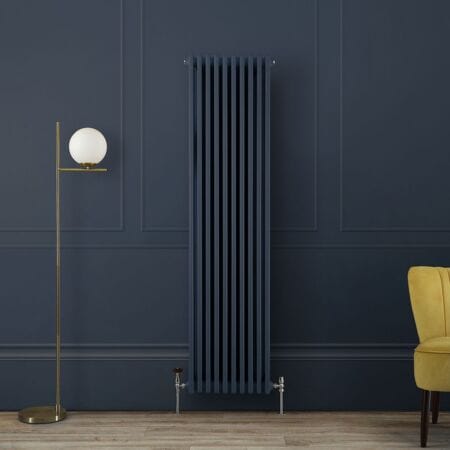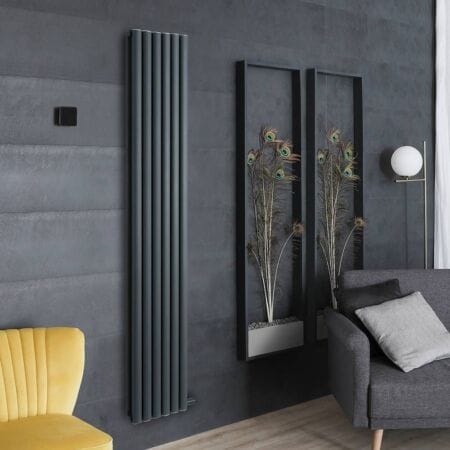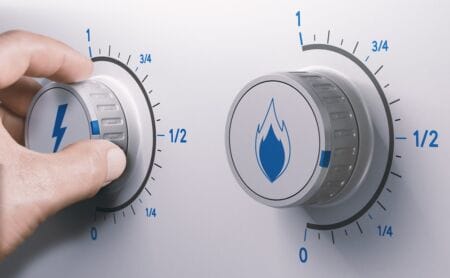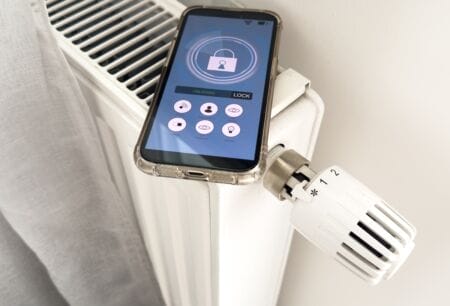Contents
ToggleWhat we'll cover...
A discussion of the best energy efficient heating habits to follow to reduce your carbon footprint.
How to heat efficiently while cutting your carbon footprint
Everybody wants a warm home. Even more so when the weather outside is frightful. But staying toasty doesn’t need to come with the caveat of rocketing energy bills, or the causing of environmental damage. Indeed, the practice of energy efficient heating habits can help to lower emissions from your heating system.
That said, changing how you use your heating system can have a massive impact on both your carbon footprint and your wallet. And the best part? It’s not about freezing in your own home. It’s about heating smarter, not harder.
So, whether you’re already flying the flag for eco-friendly heating, or just looking for a few easy sustainable heating wins, here’s your practical guide to energy efficient heating habits that help lower emissions – without making your house feel like a freezer in the depths of winter.
1. Get to know your thermostat (and use it properly)
It might sound somewhat obvious, but the thermostat is the command centre of your heating system. By setting the temperature too high, you’ll burn fuel for the sake of doing so. Set it too low, and you might find yourself shivering around the kettle to feel the benefit of the steam.
The sweet spot?
Around 18–21°C is widely considered to be the sweet spot for most people in most rooms. Every degree above that can increase your heating bill (and energy usage) by roughly 7%, which adds up very quickly.
Modern smart thermostats allow you to:
- Schedule heat for when you’re home
- Adjust temperatures room by room (for zoned heating systems)
- Control temperatures and settings remotely via smartphone
If you’re still using an outdated manual thermostat with no scheduling, you’ll feel the benefit instantly by upgrading. The difference is night and day.
2. Embrace zoned heating
Heating your entire house like you’re running a sauna resort isn’t just wasteful – it’s completely unnecessary as well.
Zoned heating enables you to warm up the rooms you use, as and when you use them. Bedrooms can be cooler during the day. Kitchens often stay warm from cooking. And that empty guest room? It can remain in chill out mode until required.
Smart radiator valves are your best friend here. Pair them with a programmable thermostat and you’ll cut emissions and costs without even thinking about it. Literally working smarter, not harder.
Your heating doesn’t need to be switched on and blaring 24/7. In fact, that’s one of the least efficient heating habits that exists.
Instead:
- Use timers to pre-warm the house before you wake up or return home from work
- Set it to switch off when you leave the house
- Avoid overnight heating unless necessary – just layer up your bedding game
Smart heating systems now let you fine-tune everything down to the minute, so you only use what you need, when you need it.
4. Audit your radiators
Your radiators might look just fine. But are they performing with the utmost efficiency they’re capable of?
Regular radiator maintenance includes:
- Bleeding your radiators to release trapped air (which stops them from heating up properly)
- Checking for cold spots (a sign of sludge or poor circulation)
- Making sure furniture isn’t blocking airflow
And if you’re still using ancient radiators that time has forgotten, it might be time to upgrade to energy efficient radiator styles. Modern designer radiators – like the Milano Aruba collection – offer higher efficiency, faster heat-up times, and better BTU-to-size ratios.
5. Lower flow temperatures = Higher efficiency
This one’s often overlooked. Modern condensing boilers operate more efficiently at lower flow temperatures – typically between 55 and 60°C.
Check your boiler settings:
- If it’s set too high (often 75-80°C by default), you’re likely burning more fuel than necessary.
- Lowering it won’t affect comfort, but it will reduce fuel consumption and boost your boiler’s efficiency.
If you’re unsure how to adjust this, check your boiler manual or speak to a plumber for advice. It’s a five-minute tweak that could save you a decent chunk over the colder winter months.
6. Choose Lot 20-compliant electric radiators
Electric heating is increasingly popular, especially for new builds, garden rooms, and off-grid homes. But there’s discrepancies in the many types of electric heaters on the market.
Each of our electric radiators are Lot 20 compliant – they come equipped with:
This is less about how you use your heating, and more about how you help it to work in the most efficient way possible.
Top heat-retention tips:
- Close doors between spaces to trap warmth inside
- Use thermal curtains and draught excluders to prevent the infiltration of cold air
- Seal around windows and doors for enhanced insulation
- Add radiator reflector panels to bounce heat back into the room
Every bit of retained warmth means less work for your heating system, and therefore fewer emissions in the process.
8. Monitor your usage
You can’t manage what you can’t measure. In essence, that is why tracking your heating usage helps you to build better habits in terms of energy usage.
Use smart apps, energy monitors or even good old-fashioned meter readings to:
- Spot trends
- Identify waste
- Test what’s making a difference to usage levels
Even if you’ve made your home heating setup as efficient as possible, the source of your energy still matters.
Switching to a green electricity supplier ensures that any power you use – particularly so for electric radiators – is backed by renewable generation like wind, solar, or hydro power.
Some tariffs even reward off-peak use, which is ideal if your heating use is well-timed and strategically zoned.
10. Think long term with sustainable upgrades
- Upgrading insulation (walls, lofts, floors)
- Installing smart heating controls in every room
- Using low-carbon heating like heat pumps or hybrid systems
- Investing in solar panels to power electric heating
These aren’t quick wins, but in fact considered serious steps towards cutting household emissions. Pair them with sustainable daily heating habits and you’ll achieve a heating system that’s truly fit for a greener future.
Heat smarter, live warmer with BestHeating
Reducing emissions doesn’t have to mean sitting in a woolly hat all winter, sipping lukewarm tea. Essentially, you just need to be a bit more thoughtful about how, when and where you use your heat.
From smart thermostats to upgraded radiators and simple daily heating tweaks, there are tonnes of easy ways to warm up your home without overloading the grid or emptying your wallet.
Tell us about your energy efficient heating habits and vices in the comments below, or reach out to us on Instagram, Facebook or X.
John is a Research Specialist for the Best Heating Advice Centre, where for over nine years he has dedicated himself to demystifying home heating for our customers. He specialises in creating clear, data-driven guides and how-to articles by collaborating directly with our team of certified heating experts and product engineers.
His work, built on a foundation of journalistic research, has helped millions of readers make confident and informed decisions about their home heating. When he’s not breaking down the heat output differentials from radiators to heated towel rails, John fancies himself as a fine football and music connoisseur.










